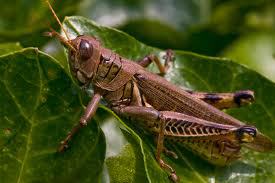The Amazing Health Benefits of Eating Grasshoppers
Grasshoppers are found intemperate
climates around the world. The grasshopper will emerge from a cluster of
eggs buried into soil, eat throughout the summer, breed in the fall and
die off before winter approaches. Grasshoppers come in diverse sizes
and shades of green. They are hunted by predators like spiders and
birds. Grasshoppers provide culinary, ecological and medical benefits.
In eastern world cooking, insects have
always been a staple item. The grasshopper is found in restaurants,
street-side carts and market displays all around Asia and India, for
instance. The grasshopper provides excellent protein and necessary
vitamins while containing negligible amounts of cholesterol and other
fats. Grasshoppers are considered a delicacy in many countries, served
with chocolate toppings or deep fried with crispy coatings. Eating
grasshoppers is ecologically beneficial as well, since insects have
numbers in the millions and are nowhere near extinction.
The grasshopper is constantly leaving
droppings behind in the ground, droppings that are rich in nutrients for
the soil and vegetation. Likewise, as the grasshopper dies off at the
end of the summer, its body is left behind to decompose and further
enrich the ground with vital minerals and vitamins. Grasshoppers are
also able to eat vegetation that is toxic to cattle and other farm
animals. These insects help to remove the poisonous weeds from the
grazing path of farm animals. Since grasshoppers emerge in spring in
very high numbers, they also serve as a main source of food for many
predatory insects like spiders and birds.
Grasshoppers have helped to develop certain medications that act upon
the nervous system, since their nervous system resembles that of a
human. Grasshoppers are used in clinical studies so that humans are not
tested on with dangerous and unpredictable drugs. Grasshoppers also help
in the study of evolution, since insects are one of the world’s oldest
forms of life. Insects have evolved over many years, yet their primitive
defenses and habits are
Scientists have only a rudimentary
understanding of grasshopper nutrition (Simpson and Bernays 1983,
Bernays and Simpson 1990). For example, grasshoppers probably require
the same 10 essential amino acids as required by mammals to support
survival, growth, and reproduction. These include arginine, histidine,
isoleucine, leucine, lysine, methionine, phenylalanine, threonine,
tryptophan, and valine. However, the exact amino acid requirement for
any grasshopper species is unknown. But scientists do know enough to
provide a basic framework for understanding grasshopper nutrition. This
knowledge is useful for predicting:
(1) why grasshopper populations respond as they do.
(2) why food consumption rates vary as they do.
(3) why some grasshopper control tactics will be more suited than others, depending on the availability of suitable food.
Equally important, cultural management
practices developed by range managers must work with naturally occurring
constraints on grasshopper food consumption. These new management
practices can be successful only if basic underlying nutritional issues
are incorporated into the planning process at the beginning.
From the grasshopper’s viewpoint, what considerations are important to feeding?1. Among insects, grasshoppers exhibit the highest total-nitrogen body content but typically feed on food that is very low in nitrogen. Since high protein content in grasshoppers comes primarily from low soluble-protein content in food plants, grasshoppers must make up this difference in protein concentration by eating and converting sufficient food material.
2. As with all organisms, an energy source fuels the basic metabolism. Grasshoppers must eat sufficient energy besides protein to prevent the conversion of scarce protein to energy. Allocation of protein to growth and reproductive functions such as cuticle (skin) and muscle formation or egg production optimizes protein use.
3. The dynamic process of balancing nutritional needs responds to many situations that can cause dramatic changes in feeding behavior. Nutritional needs change as the grasshopper develops and switches from nymphal to adult stages. Reproductively mature adults exhibit striking sex-specific differences in allocating nutritional resources. In addition, depending on the adequacy of the diet for immediate needs, internal physiological and biochemical processes may reallocate internal nutrient budgets to satisfy new requirements. As a result, certain activities, such as egg production or growth, cease if the diet becomes inadequate. These shifts probably happen often in natural environments, given that only poor-quality food is generally available to meet high-quality needs. Consequently, internal reallocation of nutrients may alter feeding behavior. These feedbacks can increase or decrease total consumption or cause switching among available food sources to adjust the intake to meet new nutritional needs.
One can manipulate the following factors to alter the nutritional economy and control of feeding: food acquisition, digestion, assimilation, utilization, and allocation. These factors interact as highly coordinated processes with many feedbacks. Figure on the top illustrates the principal tissues and organs involved in nutrient acquisition, storage, and metabolism. Such tissues interact to control acquisition and allocation of nutrients. Feedbacks control consumption rates among these components, the quality of the food, and nutrient needs. Because of this interactive system and its feedbacks, insect herbivores achieve remarkable efficiency at extracting required resources from plant material and in compensating for dietary deficiencies.
Culled from: http://healthmedicare.wordpress.com/2011/01/11/benefit-of-grasshopper/



Comments
Post a Comment